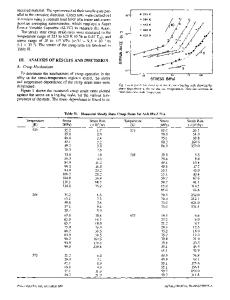Deformation Mechanisms and Ductility of Nanostructured Al Alloys
- PDF / 125,345 Bytes
- 6 Pages / 612 x 792 pts (letter) Page_size
- 24 Downloads / 451 Views
P9.1.1
Deformation Mechanisms and Ductility of Nanostructured Al Alloys Bing Q. Han a, Farghalli A. Mohamed b and Enrique J. Lavernia a Department of Chemical Engineering and Materials Science a University of California, Davis, CA 95616 b University of California, Irvine, CA 92697 ABSTRACT Low tensile ductility is one of the critical challenges facing the science and technology of nanostructured materials. As an example, despite the fact that high strength is frequently observed in bulk nanostructured Al alloys, ductility and work hardening are often observed to decrease with decreasing grain size. In the present study, the tensile ductility of bulk nanostructured aluminum alloys processed via severe plastic deformation and consolidation of mechanically milled powders is analyzed. Adding coarse grains to the nanostructured matrix is proposed as an approach to improve ductility. INTRODUCTION The successful synthesis of large-scale nanostructured materials with a grain size in the range of 10 – 200 nm represents a major achievement in the broad field of nanotechnology. In this field the synthesis of the nanostructured aluminum alloys is attractive because of the high ratio of strength to density in aluminum. Currently, the two most widely used techniques for synthesizing bulk nanostructured aluminum alloys are severe plastic deformation and consolidation of mechanically milled powders [1-4]. Data reported for the mechanical behavior of bulk nanostructured aluminum alloys have shown two trends. First, for a grain size ranging from 20 to 300 nm, the grain size softening phenomenon (e.g., reverse Hall-Petch relationship [5,6]), which is sometimes reported, is absent, and the flow strength follows the regular Hall-Petch relationship: σ = σo + k⋅d-1/2. Second, in some nanostructured aluminum alloys [2,7,8], extensive strain hardening is not observed during tensile deformation. This trend is manifested in the presence of a longer steady-stage extending from the ultimate stress to the failure point (for instance, cryomilled Al alloys [3,9]). The purpose of the present study is to provide insight into the deformation behavior of nanostructured aluminum alloys processed via the above two approaches. TENSILE BEHAVIOR OF NANOSTRUCTURED ALUMINUM ALLOYS Figure 1 shows the tensile elongation as a function of grain size for several aluminum alloys processed by two approaches, i.e., consolidation of mechanically milled powders and severe plastic deformation [2-4,8-17]. Despite considerable scatter in the data, the ductility decrease with decreasing grain size is evident. Also, the trend of data appears to indicate that the processing approach has an influence on the value of elongation. For the same grain size, the values of elongation in nanostructured aluminum alloys by severe plastic deformation are higher than those by consolidation of mechanically milled powders, probably because of the absence of processing defects in the material produced by the former technique. As reported elsewhere [18], the low tensile ductility of many n
Data Loading...











